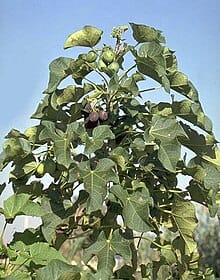
Exploring the Efficacy of Jarak pagar, the Plant with a Multitude of Benefits

Jatropha curcas Linn. is a plant that belongs to the genus Jatropha and the family Euphorbiaceae. This plant is a small tree with a height of 3-5 meters, but can reach up to 10 meters if grown in supportive environmental conditions.
Its branches have a smooth surface with a brownish green color. The leaves are heart-shaped with a dark green color, while the flowers are yellowish green, complementing the morphological characteristics of the jatropha plant.
Jatropha plants originate from the northeastern part of South America and areas with a dry climate in Mexico. However, currently jatropha plants have been widely cultivated in tropical and subtropical regions in Asia and Africa.
Content and Benefits of the Jatropha Plant

Source : Wikipedia
Jatropha plants have a fairly high protein and oil content in their seeds. This abundant oil content has been utilized for hundreds of years for the production of soap and fuel for lighting lamps.
In addition, the oil is also used in the manufacture of candles and cosmetics. The remaining seed processing after oil extraction (seed cake) is rich in protein and can be used as a nutritious and economical protein supplement for animal feed, as long as it has gone through a processing process to remove the toxic compounds contained therein.
Based on the results of the study, the jatropha plant is reported to contain various types of secondary metabolites that are spread throughout the plant parts. These secondary metabolites include diterpenes, sesquiterpenoids and triterpenes, alkaloids, flavonoids, phenolic compounds, lignans, neolignans, coumarins and coumarino-lignoids, phytosterols, and proteins.
Each type of secondary metabolite has derivatives that can produce biological activity. For example, diterpenes in the jatropha plant have derivatives that show various biological activities, such as antimicrobial, antitumor, cytotoxic, antiproliferative, anti-invasion of tumor cells, gastroprotective, insecticidal, antiplasmodial, moliscicidal, lesmanicidal, and trypanocidal.
Based on several studies conducted in vivo, the castor oil plant is reported to have pharmacological activity in the form of anti-inflammatory from ethyl acetate and methanol extracts from the leaves, water extracts from the bark and leaves, and alcohol extracts from the roots, stems, and leaves of the plant. The anti-inflammatory properties produced are related to the ability of the extract to inhibit the activity of iNOS which is an enzyme that produces nitric oxide compounds that are often involved in the inflammation process.
The castor oil plant also has other pharmacological activities based on study reports. These pharmacological activities include antioxidant, anti-microbial, anti-cancer, anti-diabetic, anti-viral, analgesic, hepatoprotective, wound healing, and anticoagulant and procoagulant activities.
Studies on the antioxidant activity of the castor oil plant which showed that water, ethanol, and methanol extracts, as well as fractions of methanol extracts made from the nodes, leaves, stems, and roots of the Jatropha plant showed antioxidant activity. Meanwhile, a study of the anti-diabetic activity of the Jatropha plant which showed that 50% ethanol extract from the leaves of the plant at doses of 250 and 500 mg/ml against the body weight of mice was proven to be able to reduce blood sugar levels, which means it can overcome hyperglycemia.
Read more:
Unbelievable! Lime Can Cure Diabetes?
Take Advantage of the Potential of the Jatropha Plant
Before being used in drug formulations or other health products, the Jatropha plant needs to go through a series of strict laboratory tests. Toxicity, effectiveness, and stability tests are needed to ensure that the active ingredients in it are safe and provide the expected benefits.
Proper testing can help ensure that Jatropha-based products meet regulatory standards and can be trusted by consumers. With its various contents and benefits, the Jatropha plant has great potential in the health, beauty, and renewable energy industries.
If you want to dig deeper into its benefits or need testing services to ensure the quality and safety of the active ingredients in this plant, be sure to work with a laboratory that has high experience and credibility.
Reference:
Abdelgadir, H. A., & Van Staden, J. (2013). Ethnobotany, ethnopharmacology and toxicity of Jatropha curcas L. (Euphorbiaceae): A review. In South African Journal of Botany (Vol. 88). https://doi.org/10.1016/j.sajb.2013.07.021.



